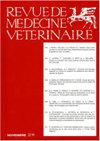Asociación de medidas morfométricas con grasa en el anca en caballos de salto en una escuela ecuestre de Bogotá
Q2 Veterinary
引用次数: 6
Abstract
The study aimed to determine the relationship of morphometric measurements and body fattening measured by ultrasound in jumping horses at an equestrian school in Bogota. Adult male jumping horses in training, mixed breed of Argentine and Colombian Creole (n = 9), were measured. The analyzed measurements were wither height (WH), thoracic perimeter (TP), body length (BL), hind leg perimeter (HLP), actual weight (AW), estimated weight (EW), backfat thickness (BT), rump fat thickness (RFT), and loin eye area (LEA). To estimate fattening, body mass index (based on morphometric measurements) and body fat percentage (based on fat measurements by ultrasound) were calculated. Descriptive statistics and principal component analysis were performed. The averages found for WH, TP, BL, HLP, AW, EW, BT, RFT, and LEA were 1.69 ± 0.02 m, 1.89 ± 0.04 m, 1.67 ± 0.07 m, 26 ± 1.82 m, 526 ± 36 kg, 525 ± 33 kg, 2.34 ± 0.32 mm, 2.12 ± 0.15 mm, and 58 ± 4.7 cm 2 , respectively. The estimated average body mass index was 183.97 ± 11, and the average body fat percentage was 14.07 ± 0.85. The two methods for estimating fattening (r = 0.41) were significantly correlated.在bogota的一所马术学校,跳跃马的形态测量与臀部脂肪的关联
本研究旨在确定波哥大一所马术学校的跳马的形态测量与超声测量的体增肥之间的关系。测量了阿根廷和哥伦比亚克里奥尔混血训练中的成年雄性跳跃马(n = 9)。分析的测量指标有:臀高(WH)、胸围(TP)、体长(BL)、后腿围(HLP)、实际体重(AW)、估计体重(EW)、背脂厚度(BT)、臀脂厚度(RFT)和眼围(LEA)。为了估计肥胖,计算体重指数(基于形态测量)和体脂百分比(基于超声脂肪测量)。进行描述性统计和主成分分析。WH、TP、BL、HLP、AW、EW、BT、RFT和LEA的平均值分别为1.69±0.02 m、1.89±0.04 m、1.67±0.07 m、26±1.82 m、526±36 kg、525±33 kg、2.34±0.32 mm、2.12±0.15 mm和58±4.7 cm 2。估计平均体重指数为183.97±11,平均体脂率为14.07±0.85。两种方法的增肥率呈正相关(r = 0.41)。
本文章由计算机程序翻译,如有差异,请以英文原文为准。
求助全文
约1分钟内获得全文
求助全文
来源期刊

Revue De Medecine Veterinaire
农林科学-兽医学
CiteScore
1.30
自引率
0.00%
发文量
0
审稿时长
18-36 weeks
期刊介绍:
The Revue de Médecine Vétérinaire publishes four kinds of text:
1) Scientific reviews on subjects related to veterinary and comparative medicine. Suggested length: 10 to 30 typed pages.
2) Original reports on fundamental or applied research. Suggested length: 10 to 15 typed pages.
3) Continuous education articles, that should be easily understandable by non-specialists. Suggested length: 10 to 15 typed pages.
4) Clinical reports. Suggested length: 5 to 15 typed pages.
The publication can be done in French language or English language.
For an article written in English by not english native speakers authors, the manuscript must be subjected by attesting that it was read again by an anglophone scientist or a scientific translator.
The authors must certify that the manuscript was not published or subjected for publication to another review.
The manuscript must be accompanied by a sheet signed by all the joint authors indicating their agreement for the tender of the manuscript.
The publication is free but a financial participation could be required for the photographs color. An estimate will be sent to collect the agreement of the authors.
 求助内容:
求助内容: 应助结果提醒方式:
应助结果提醒方式:


